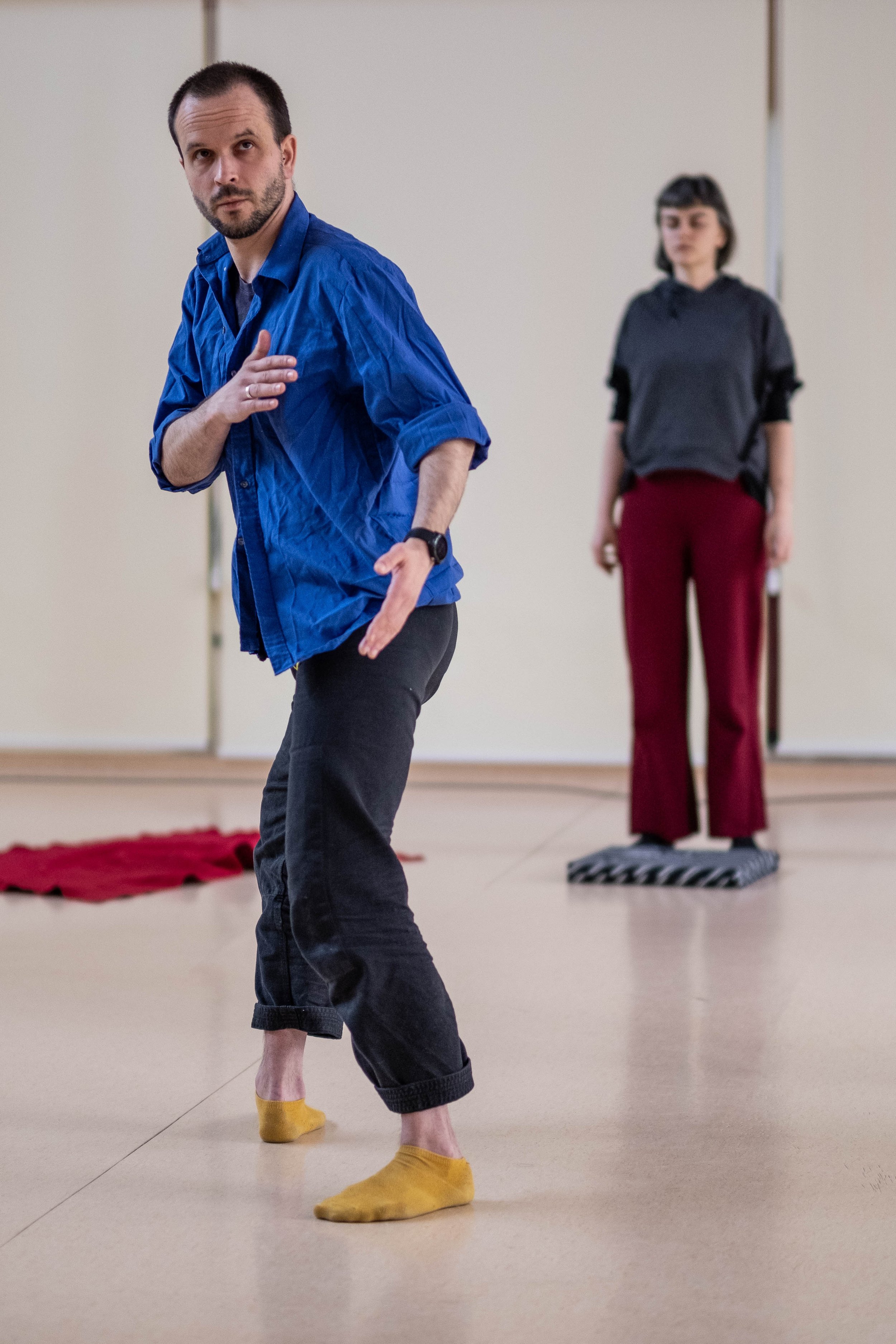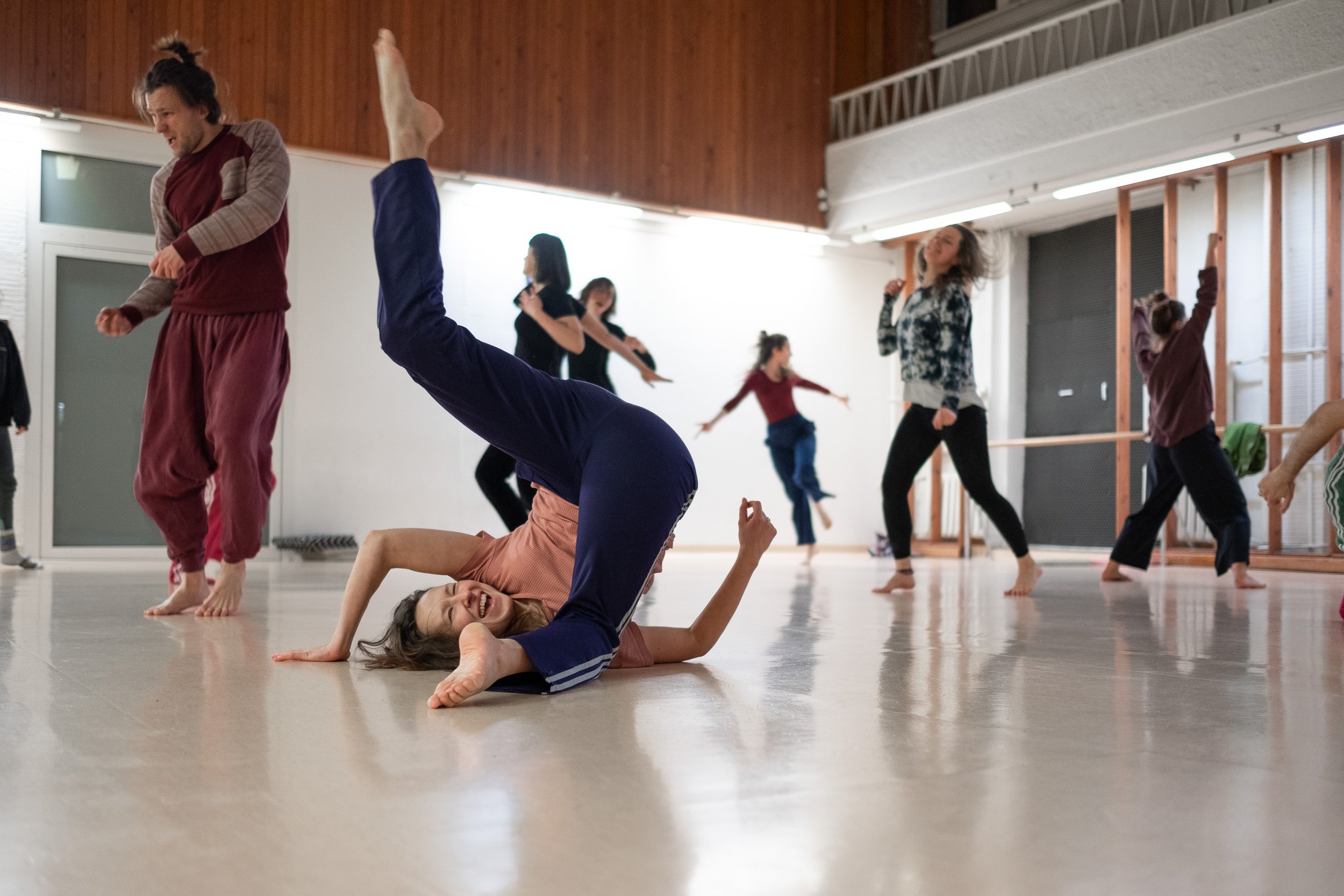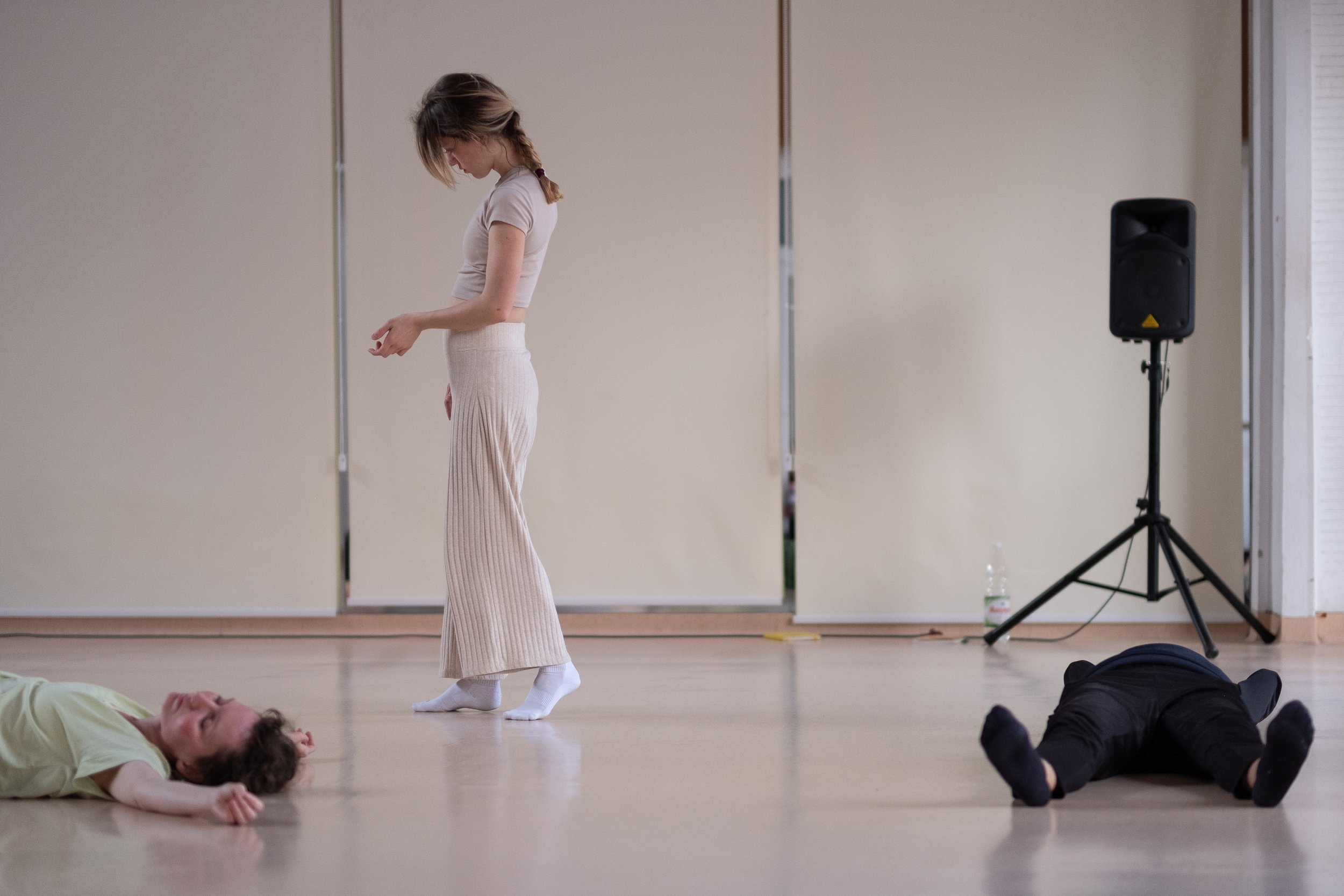I first heard of contact improvisation in the spring of 2022. As an unstructured dance form, it sounded like the natural next step in my body’s progression from unduly tense yoga to Gaga, meditation, and the Feldenkrais Method. As a social experience, however, it sounded like courage itself. Would I have the nerve to try? Someone recommended I study with Andrzej Woźniak, but this was May, classes were full, teaching would commence after the summer. Then, as I readied myself to select between the beginner CI group (on Monday evenings) and the mixed-level morning class (Wednesdays, padded floors), I wound up drawn instead to Andrzej’s mysterious-sounding BMC-inspired course of study. A year of once-monthly two-day intensives devoted to embodied awareness, it was to be a master class based in part on Body-Mind Centering, the perplexing and liberating somatic method developed by Bonnie Bainbridge Cohen in California over the past fifty years. (I had only just heard of BMC in July ’22 at Warsaw Flow, my immersive CI debut.) I signed up for this intimidating yearful of weekends, September came, I met Andrzej.
The workshops unfolded at Warsaw’s Studio 42 in centrally-located Twarda. Eighteen of us were mostly in for the long haul, though every weekend saw a pop-in or several that only affirmed our growing sense of community. Among us were tea whisperer Ivan, graceful Tatiana of cranio-sacral therapy, award-winning schoolteacher and slam-winning poet Ola, pro-swimmer and showbiz ingénue Wera, theatre actor and fellow writer Kasia, philosopher turned fashion designer Mona, and gleaming-eyed Hania with the quicksilver mind. All of us shared the desire to be there and the capacity to pay attention to the quiet storytelling of bodies, which was, to begin, quite a lot to have in common with a bunch of strangers.
I soon discovered that Andrzej is often solidly present, usually self-contained, and drawn not to the flowing harmony of beachy promo videos for luxury contact all-inclusives, but to the unprocessed experimental dynamism foundational to the art-sport of CI. He’s a natural play-fighter, in other words, with so much reverence for surprise that if you’re a beginner you might find dancing with him kind of disorienting. The opposite, however, can be said of Andrzej’s teaching style, because as a facilitator and as a communicator he combines playfulness with discipline in proportions conducive to learning. There is energy, joy, and defiance to Andrzej’s leadership—but instructions are clear, boundaries are honored, breaks are on time, and truth is never sacrificed for laughs or expediency.
By the time I also joined Andrzej’s weekly contact improvisation class on the soft floors of a Grochów karate school, I felt completely at ease in his presence and increasingly fluent in the language of intuitive movement-based human touch. Plus, in addition to Wednesdays, I now had the occasional Saturdays, too: monthly late-morning focus jams open to Andrzej’s entire CI student body. For me these were the Goldilocks of opportunities for my dance practice—safe and familiar in one way, ceremonious and thrilling in another, populated with a changing cast of characters I knew only partially, with whom we all had Andrzej in common. That these spellbinding gatherings ended with unrushed guided bodywork exchanges was a very nice touch, as were the slim contemporary poetry books Andrzej laid out around the room for those on a contemplative break from the dancing.
Did I mention Andrzej is himself a published poet? It’s really unsurprising when you consider the mastery he has over the way he expresses himself and his capacity for impressive lexical and phrasal improvisation. In fact, Andrzej is a true multihyphenate, one whose roster of roles includes not just movement-and-somatics teacher, outré performer, and poet, but also bodywork practitioner, punk rocker, and the kind of lefty activist that’s able to make a lifelong liberal blush.
In late June, the weekend gang met up for a farewell celebration on a sandy strip of Wisła riverbank. After Andrzej handed out our diplomas, he invited each of us to name three things we got out of this 160-hour pilot intensive. Our descriptions were idiosyncratic, but the objects of our gratitude were universal: Andrzej enriched our lives by deepening our capacity to know what we’re feeling, by educating us about the body as an instrument for living, and by creating the conditions for us to get to know both him and one another.
What began for me with voice lessons ten years ago has developed into a total body-driven journey toward knowing what lights me up and where I’m holding resistance. Along the way, I have explored numerous investigative, therapeutic, and creative disciplines, discovering which of them bring me ease and which teachers and practitioners “speak my language.” To say that studying BMC and CI with Andrzej Woźniak from September ’22 to June ’23 has been life-changing for me is to be accurate with my assessment and not hyperbolic at all.
It’s an honor and a delight to be publishing some of the photos I took during Andrzej’s weekend workshops and weekday classes. They seem to capture not just what I witnessed happening around me, but also the state I was in at the time, one of slowed time, heightened perceptiveness, and deepened appreciation for beauty.
Acknowledgments and Afterthoughts
Interested in taking your bodymind game to the next level? See when Andrzej has a class, workshop, or training course right for you.
Most photos are from Andrzej’s ’22–’23 Contact Improvisation and Bodywork Training Course Based on the Body-Mind Centering Method. Some are from Andrzej’s weekly Padded-Floor All-Levels Contact Improvisation Morning Classes held last Winter and Spring.
All images taken by the author and posted with permission from Andrzej and the other participants, a few of whom initially asked not to be photographed, but later reconsidered. Many mentioned feeling at ease with my picture taking—or being pleased in response to the way they’ve been captured. Thus, in addition to thanking Andrzej for the lessons and circumstances, I also wish to thank the people in the photos—Tatiana Dziewanowska, Weronika Gotowska, Mona Rena Górska, Tomek Gromadka, Natalia Jabłońska, Katarzyna Juchimiuk, Marcin Kosewski, Ola Korczak, Ania Kowalska, Olga Lidia Kozłowska, Kama Królikowska, Monika Leszczyńska, Sebastian Magdziński, Ania Matuszczak, Dorota Mentel, Hanna Moroch, Marta Olak, Bożena Osmola, Magda Pawluk, Paulina “Papaja” Rozmus, Ivan Sitsko, Rafał Soszyński, Kasia Stankiewicz, Marta Szwed, Anna Maria Tuszyńska, Agata Waszkiewicz, and Kamila Zięba.
Andrzej Woźniak’s name is pronounced roughly as AHNJ-zhey VOZH-nyak. Andrzej is the Polish version of Andrew. Woźniak is the tenth most frequent last name among male Poles and it derives from a patronymic based on the word once used to denote the person whose job was to serve legal documents. Etymologically Woźniak shares a root with the basic transitive verb wozić—to deliver, to transport, to drive/carry.
To call Body-Mind Centering a “perplexing and liberating somatic method developed by Bonnie Bainbridge Cohen” —as I did at the top of this post—is to put the onus of defining BMC on the reader. It’s also an understandable way to dodge explaining the nearly inexplicable, as all those who have studied or taught BMC sometimes do. Even Bonnie notes the way her method evades defining (in the intro to the second edition of her book The Mechanics of Vocal Expression, 2015).
One of the major problems that arises for people who study with me is that they feel they don’t know what they are learning. The reason for this, I believe, is that I am teaching their unconscious.
For a comprehensive introduction to BMC, I recommend Bonnie’s Intro to BMC whitepaper (which I’ve had the honor of copy-editing!), available at no cost on bonniebainbridgecohen.com. If, however, you insist I live up to my reputation and issue a necessary-and-sufficient definition here and now, what follows is how I would distill BMC to its essence by remixing language that echoes Bonnie’s own.
Body-Mind Centering is an approach to body awareness and embodied movement based on the way the body naturally communicates a person’s thoughts, feelings, and spirit. BMC’s goals are to illuminate how the mind is expressed through the body in movement and to effect desired changes in the body-mind relationship. Importantly, the idea of centering refers to an experiential balancing process, not a place of arrival.
BMC and Body-Mind Centering are registered trademarks of Bonnie Bainbridge Cohen.
It shall not go unmentioned that yet another light-filled thing Andrzej brought into my life was the lyrical genius of English performer Kae Tempest—and countless opportunities to move my body to their breathtaking warnings and sounds.
One last thing—when my mom read this post she had one criticism: not enough photos of me. So here are three, in case she visits again. They are from Andrzej’s mid-March BMC-inspired intensive devoted to glands and hormones and were taken by Bartosz Jakubowski, whose camera is way bigger than mine.







































